 |
| A canal in the centre of Colmar, Alsace. Photograph: Alamy |
A part of France with a hint of Germany, this region’s forests and hills shelter beautiful cities and villages, superb vineyards and cosy restaurants and hotels
Alsace runs west to east from the pine-clad Vosges mountains through some of the most beautiful vineyards in France, to the mighty Rhine river and the border with Germany. Changing hands several times over the centuries between France and Germany has only strengthened the independent character of this fiercely traditional region, where a unique dialect is still the most popular spoken language.
I don’t think I have ever travelled through any other part of France where visitors are given such a genuinely warm welcome, both in the vineyards (Alsace is one of the world pioneers of wine tourism) and the mountains, where an outdoor holiday can take in biking, boating, trekking and fishing. The food is out of this world and distinct from other French regions. A foaming beer is just as popular as a glass of wine, and specialities include not just foie gras and escargots but juicy ham hock with steaming choucroute, pike-perch poached in riesling and spicy gingerbread.
The main towns
What to see and do
The region’s capital is Strasbourg, particularly famous for being the seat of several European institutions and its magnificent red sandstone Gothic cathedral, the world’s tallest building between 1647 and 1874, now celebrating its millennium (its first stone was laid in 1015). The interlocking waterways and brightly painted half-timbered houses of La Petite France, the historic leather-tanning district, is a picturesque must-see, but be prepared for crowds of visitors. More offbeat, and quieter, is the Musée Alsacien, an enchanting maze of rooms illustrating Alsace’s unique culture, and the Cave Historique des Hospices de Strasbourg, a 14th-century wine cellar beneath the modern city hospital, which boasts a barrel of the world’s oldest wine, miraculously preserved since 1472.
The region’s capital is Strasbourg, particularly famous for being the seat of several European institutions and its magnificent red sandstone Gothic cathedral, the world’s tallest building between 1647 and 1874, now celebrating its millennium (its first stone was laid in 1015). The interlocking waterways and brightly painted half-timbered houses of La Petite France, the historic leather-tanning district, is a picturesque must-see, but be prepared for crowds of visitors. More offbeat, and quieter, is the Musée Alsacien, an enchanting maze of rooms illustrating Alsace’s unique culture, and the Cave Historique des Hospices de Strasbourg, a 14th-century wine cellar beneath the modern city hospital, which boasts a barrel of the world’s oldest wine, miraculously preserved since 1472.
Mulhouse, 100km south of Strasbourg (off the above map), is the region’s second city, best known for its vast transport museums Cité de l’Automobile (hosting the world’s biggest collection of Bugattis among hundreds of vintage and racing cars) and Cité du Train, and is primarily an industrial town. Between the two cities isColmar, whose ancient centre is criscrossed by romantic lanes and canals. The town is an architectural goldmine of gothic, renaiissance and baroque mansions and churches. Foodies should not miss the ornate covered market.
Where to eat
Most of Strasbourg’s traditional winstube (winebars) have been transformed into restaurants, the perfect place to sample local specialities. Cross the river Ill, just outside the historic centre, to eat at Au Pont du Corbeau (mains from €17, 21 Quai Saint-Nicolas, +33 3 8835 6068), whose menu ranges from escargots and homemade goose foie gras to grumbeerekiechle – tasty potato pancakes with crunchy smoked bacon. In La Petite France, La Maison des Tanneurs (mains from €22, 42 rue du Bain aux Plantes, +33 3 8832 7970, maison-des-tanneurs.com) serves an unforgettable choucroute, steaming fermented cabbage topped with a vast pig’s knuckle, salted pork and assorted sausages, though vegetarians will be relieved to discover Pur etc (mains from €7, 122 Grand Rue, +33 9 8378 3879,pur-etc.fr), whose chefs work directly with local farmers. Colmar has plenty of atmospheric winstube, like the waterside Brenner (mains from €15, 1 rue Turenne, +33 3 8941 4233, wistub-brenner.fr), but the best address to mix with the locals is the opulent Brasserie Le Théâtre (mains from €18, 1 rue des Bains, +33 3 8929 2929, restaurantletheatre.net).
Where to drink
With Strasbourg’s big student population there are many cheap and cheerful bars.Au Brasseur (22 rue des Veaux, aubrasseur.fr) is a buzzing microbrewery with artisan beers, such as chocolate malt, while Troquet des Kneckes (112 Grand Rue,on Facebook), “the catapult bar”, has just opened, with flea market sofas and armchairs, free table football and a big selection of Alsace wines. For live music and clubbing, finish the night at Fat Black Pussycat (3 rue Klein, on Facebook). Colmar may be quieter but there is a great atmosphere in the bustling Bistrot des Halles (13 rue des Ecoles), right in the middle of the food market, and for an after-dinner drink, pop into the cosy bar of Schwendi Bier und Winstub (23 Grand Rue).
Where to stay
The funkiest place to stay in Strasbourg is Hotel Graffalgar (doubles from €90, breakfast €8, graffalgar-hotel-strasbourg.fr), where graffiti artists have decorated each room, ranging from an Escher-like hommage to Stanley Kubrik in room 203 to the psychedelic bordello of 303. Hotel Suisse (doubles from €87 B&B, hotel-suisse.com) is perfectly placed opposite the cathedral and Room 33 has a view of the towering pink spire. Colmar’s Hotel Le Colombier (doubles from €126, breakfast €14, hotel-le-colombier.fr) is a chic boutique property, while the picturesque half-timbered Hotel Saint Martin (doubles from €95 B&B, hotel-saint-martin.com) offers much more traditional, homely Alsace decor.
The wine route
What to see and do
Founded in 1953, this is the oldest wine route in France, stretching over 150 miles (in the shadow of the Vosges, roughly from the west of Mulhouse to the north of Strasbourg) with more than 1,000 vignerons welcoming visitors to their cellars for a free wine tasting. In September and October the tourism offices of villages along the wine route organise half-day excursions for tourists to join in the grape harvest.
The Alsace wine villages have a fairytale quality with their brightly painted cottages, medieval ramparts and distinctive stork nests delicately balanced on church spires. The most beautiful – Riquewihr, Eguisheim, Kaysersberg and Bergheim – are very popular with visitors over the summer, so autumn’s a good time to visit, but there are plenty of quieter hamlets such as Saint-Hippolyte and Katzenthal waiting to be discovered. For a cultural break from eating and drinking, visit the medieval Haut-Koenigsbourg, an imposing hilltop chateau, or drive up to the mystic Mont Sainte-Odile, a seventh-century abbey which has its own hotel for visitors who want to stay the night (doubles from €86, breakfast €9.80, mont-sainte-odile.com). A great stop-off for anyone travelling with kids is the bewitching Gingerbread Museum (paindepices-lips.com), in Gertwiller, where master baker Michel Habsiger has created a museum dedicated to Hansel and Gretel filled with a cornucopia of retro toys. His boutique is a wonderland ofgingerbread and paver varieties.
Where to eat
There are plenty of Michelin-starred dining rooms, such as Olivier Nasti’s 64° Le Restaurant (9-13 rue du General de Gaulle, +33 3 8947 1017, lechambard.fr), but the bill in these splash-out restaurants is usually going to add up to more than €100 a head. A much better bet is to join the locals in a winstub. Between Strasbourg and Colmar, check out Molseim’s Caveau de la Metzig (mains from €12, 1 Place de l’Hôtel de Ville, +33 3 8838 2624, restaurant-la-metzig.fr), housed in a 16th-century butcher’s guildhall, or the lively Les Petites Casseroles(mains from €15, 128 rue du Général Gouraud, +33 3 8804 7021) in the centre of Obernai. Look out for dishes such as flammekuechen, the Alsace take on pizza, a wafer-thin flatbread smothered with creamy fromage blanc and bacon, andbaeckeoffe, a slow-baked casserole of lamb, beef and pork. South of the wine route, the sleepy village of Nierdermorschwihr has several great addresses. Among them is Caveau des Chevaliers de Malte (mains from €12, 127 rue des Trois Epis, +33 3 8927 0978, caveau-chevaliers.fr), perfect for plump escargots in garlicky butter or veal tripe braised in riesling.
Where to taste wine
Choice is not the problem when it comes to tasting wine, though be prepared for lengthy sessions, as each vigneron will open up a dozen whites – sylvaner, riesling, gewürztraminer, pinot blanc – the region’s distinctive red, a light pinot noir, and bubbly crémant d’Alsace. A good place to start understanding these complex vintages is one of the big co-operative cellars, like the Cave de Turckheim (cave-turckheim.com), which has unbeatable prices as well as high quality, or just turn up at the vineyards of two historic winemaking families:Maison Emile Beyer (emile-beyer.fr) and Hugel et Fils (hugel.com). Alsace has an outstanding selection of organic, biodynamic and “natural”, no-sulphite vignerons. Two to track down are Domaine Weinbach (appointment only, + 33 3 8947 1321, domaineweinbach.com), for an incredible pinot gris, or the DomaineAlbert Seltz (appointment only, +33 3 8808 9177, albert-seltz.com), where the eponymous, exuberant owner has raised the humble sylvaner grape into an exquisite grand cru.
Where to stay
The Route des Vins is lined by friendly, affordable winemaker B&Bs, the perfect places to let vignerons explain their wines over a relaxed tasting. Dambach-la-Ville is a sleepy village off the beaten track and André Ruhlmann (doubles €62 B&B, ruhlmann-schutz.fr) loves to whisk his guests on a tour of vineyards that have been in his family since 1688. Au Canon (doubles from €45 B&B,aucanon.com) sits by the ancient ramparts and steep vineyards that enclose the hamlet of Andlau. It used to be the local bistrot, but Madame Nicolas has converted it into a cosy B&B, while her son, a creative young chef, prepares gourmet private dinners for guests who book them in advance. Staying at theButterlin family’s chambres d’hôte (doubles from €65 B&B, gites-kientzheim) is like stepping back in time, with ancient cot-like beds in snug wood-panelled rooms. The owners have plenty of suggestions for cellars to visit along the pretty cobbled streets of Kientzheim, where every inhabitant seems to make wine. For travellers preferring the comfort of a hotel, most villages have several old-fashioned auberges, such as Hotel Hassenforder (doubles from €70, breakfast €7.50, roger-hassenforder.com), right in the heart of Kaysersberg.
Vosges national park
What to see and do
The Vosges mountains run through Alsace from the summit of the 1,400-metre Grand Ballon in the south, then north along the hair-raising bends of the Route des Crêtes, the Petit Ballon and Col de la Schlucht – regularly featuring in stages of the Tour de France – up to the border with Germany. Here, the crowds that follow the wine route thin out, and the low mountains, lakes, waterfalls and forests are a paradise for walking and biking, hang-gliding, canyoning and horse riding. Then, when the winter snows arrive, this ranks as the best region in France for cross-country skiing. A favourite waterfall to walk to is just outside Le Hohwald, 40 minutes’ drive south-west of Strasbourg, where a sign for “Cascades” leads along a thick forest path where the river Andlau cascades down a steep waterfall.
Not all the attractions are outdoor, as at Sainte-Marie-aux-Mines there is a breathaking trip down an ancient silver mine, while the Vallée de Villé is lined with artisan distilleries that make fruit brandies. At Distillerie Nusbaumer (jos-nusbaumer.com) the tasting room is usually packed – be sure that someone acts as designated driver.
Where to eat and drink
This is the land of the ferme-auberge where every pine-clad valley has signs directing travellers to working farms with rustic restaurants. Just outside Le Hohwald, the Deissler family raises cows at the Ferme Auberge Lindenhof (mains from €12, 11 route du Kreutzweg, +33 3 8808 3198, ferme-auberge-lindenhof.fr) and the roadside diner offers delicious dishes such as succulent roast veal with a creamy wild mushroom sauce and Alsatian spaetzle egg pasta.
In the region where Munster cheese is produced, the Ferme Auberge Kahlenwasen (mains from €7, Luttenbach-près-Munster, +33 3 8977 3249, on Facebook) sits on a 1,000-metre-high plateau across from the Petit Ballon, and Madame Lochert prepares rustic recipes including a wonderful dessert – fresh, milky Munster floating in home-brewed kirsch. At the village of Soultzeren, a narrow track through thick forest comes out at the breathtaking Ferme Auberge du Lac de Forlet (mains from €8, Lac des Truites, Soultzeren, +33 3 8977 4922). It overlooks a stark glacial landscape and what locals call “trout lake” but, rather than fish, it does simple omelettes and cured ham because no one fishes in the lake anymore.
Where to stay
Auberge du Mehrbächel (doubles from €65, breakfast €9.50, auberge-mehrbachel.com) is perfect for exploring the nature trails of the Grand Ballon. The chalet-style rooms have cosy rustic decor and the chef’s speciality is locally caught trout.
For a more personal stay, Les Arts Verts (doubles €80 B&B, chambre-les-arts-verts.com) is an arty new B&B by lake Kruth-Wildenstein, where guests can visit the printmaking studio of owner Didier and have access to a sauna. Driving along to the silver mines of Sainte-Marie-aux-Mines, it is impossible to miss the bright yellow facade of Auberge de la Canardière (doubles from €43, breakfast €6,auberge-de-la-canardiere.fr). The very reasonably priced rooms are basic, and the chef tempts guests with his homemade terrines and smoked wildboar ham.
For total pampering, splash out at the luxurious Hostellerie La Cheneaudière(doubles from €185 B&B, cheneaudiere.com). A stay includes use of the spa, with a sauna, hammam, water-jet massage and Jacuzzi.
• John Brunton was a guest of Hostellerie La Cheneaudière. Car hire was provided by carrentals.co.uk. More information is available at tourisme-alsace.com androute-des-vins-alsace.com. EasyJet and Ryanair fly direct to Strasbourg from Stansted and Gatwick, with returns from £10. Returns on Eurostar (change at Paris, eurostar.com) from £98.
By John Brunton, www.theguardian.com
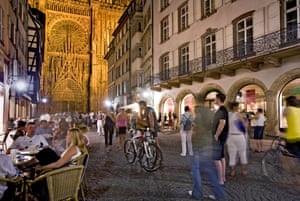
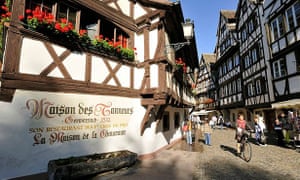
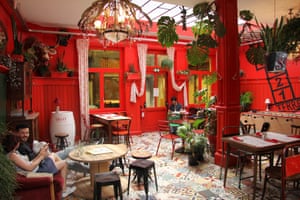
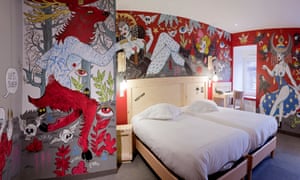

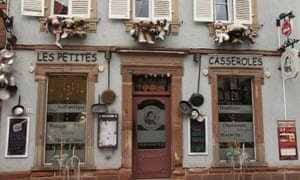
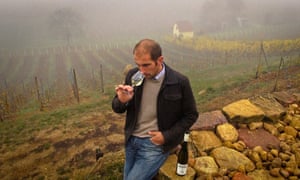
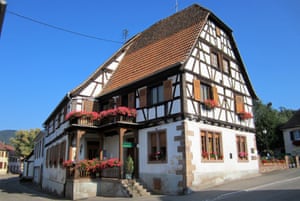
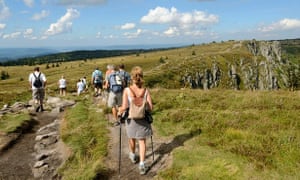
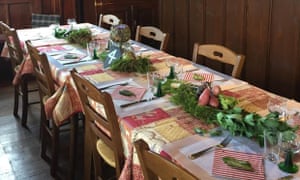
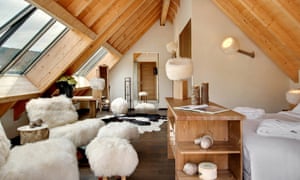
No comments:
Post a Comment